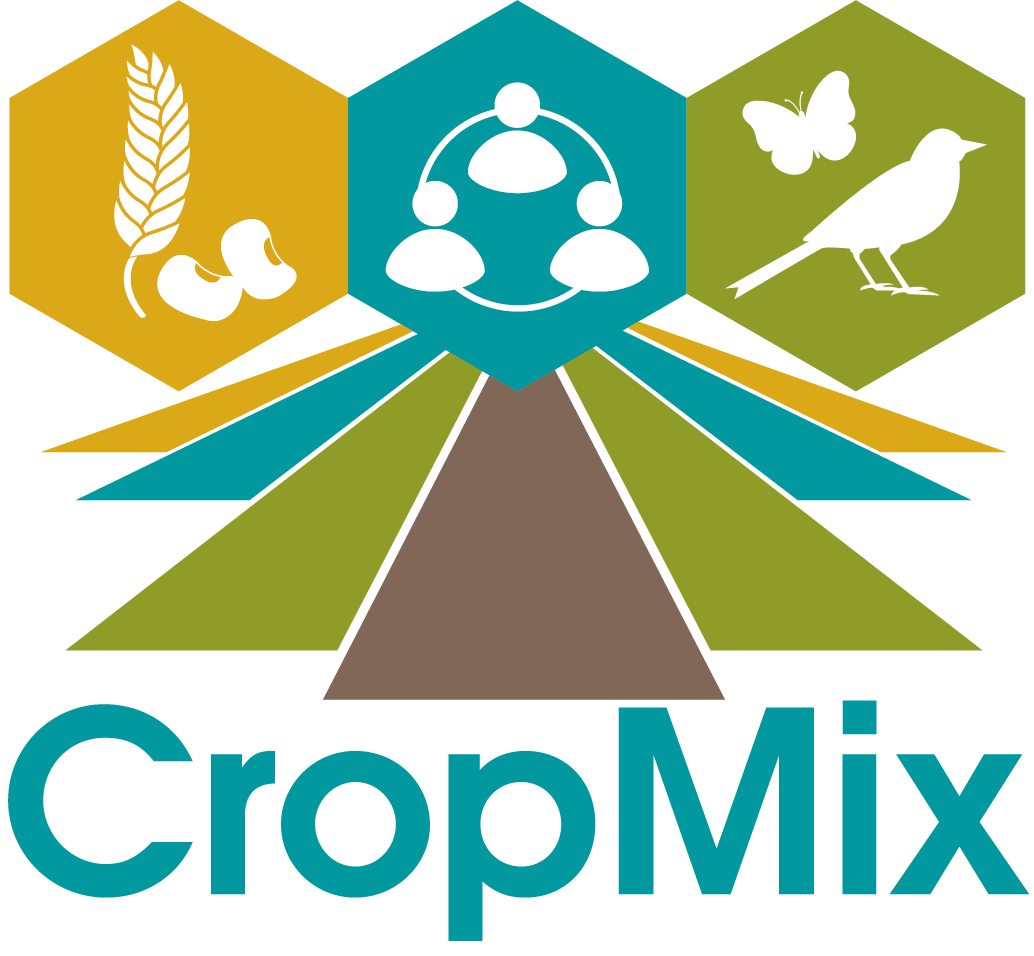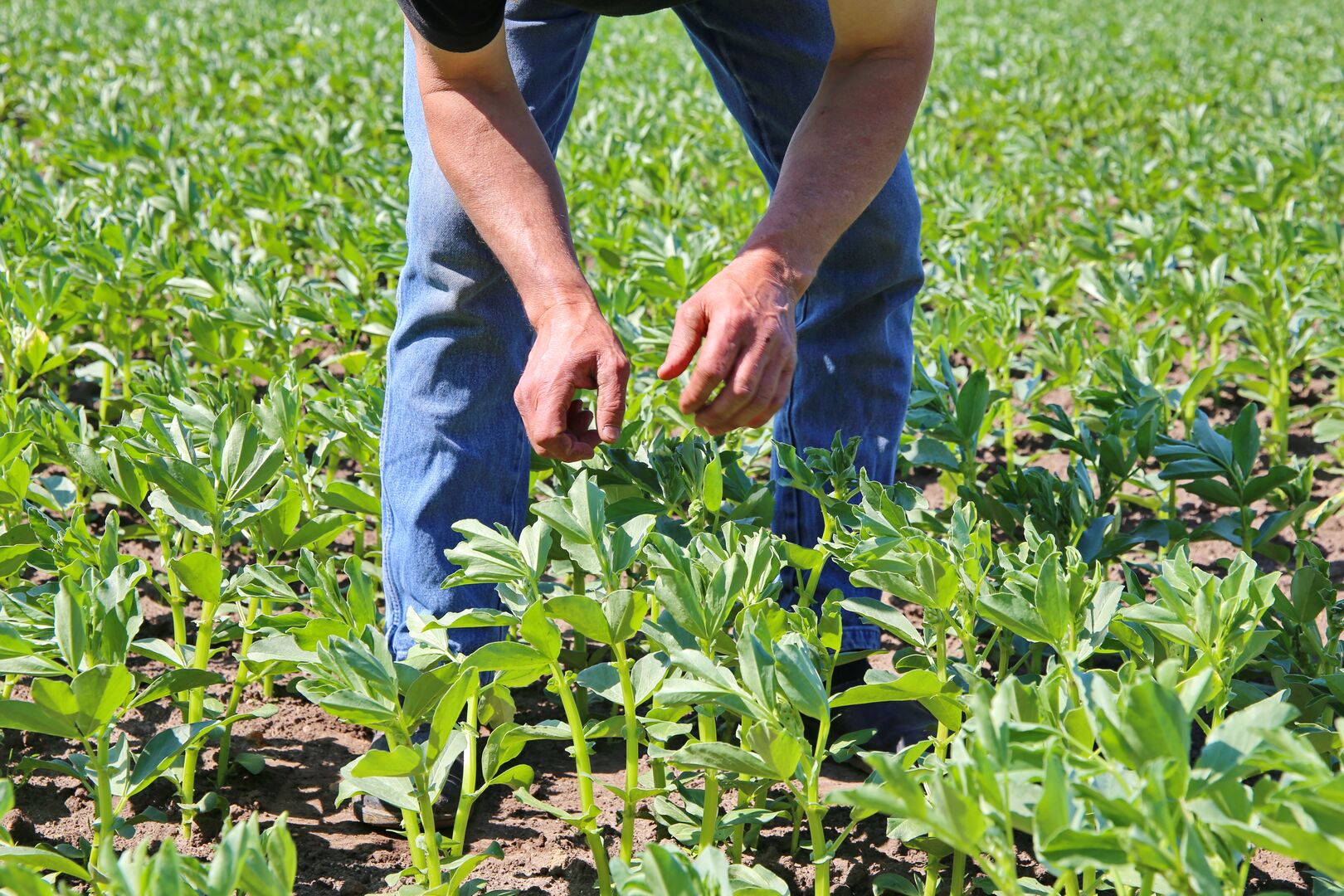Results MoestuinMix 2024
One of the aims of our experiment was to harness knowledge from allotment/vegetable gardeners that could be of value to arable farming, especially when it comes to strip cropping or other forms of crop-diverse cropping systems. We asked participants all to choose a crop of choice to combine with broad beans and also why you chose this crop.
Below you can read our preliminary results of 2024. To draw even better conclusions, we will repeat the experiment in 2025.
Top 10 choice crops
Below you can see the participants' top 10 most common choice crops. Behind them, you can read the most common reasons for combining this crop with broad beans.
- Red beets - Have an equal growing season with beans; fit into crop rotation schedule; are a crop that often does well; broad beans provide shelter for beets
- Potatoes - Nitrogen from broad beans benefits potatoes
- Onions - The smell of onions repels insects
- Cabbage - Nitrogen from broad beans beneficial for cabbages; they have an equal growing season
- Peas and pods - Are from the same plant family so fit into the same box in crop rotation
- Flowers - Attracting pollinators and natural enemies; luring aphids away from beans
- Maize - The 'Three sisters': beans, maize and pumpkin
- Lettuce - Nitrogen from broad beans can be used for lettuce; has an equal (early) growing season; broad beans shade lettuce; lettuce covers the soil between bean plants
- Courgette - Low courgette plants alternate well with tall broad beans; they can use the nitrogen from beans for growth; during flowering, courgette attracts pollinators
- Chard - Easy-to-grow crop that you can harvest quickly; more resistant to slugs than, for example, lettuce
Yield
Ultimately, one of our goals was to analyse which combinations with broad beans now work better or less well than others. Participants investigated this by measuring the yield of both beans next to pumpkin and beans next to their self-selected crop.
For each garden, we compared the yield of beans next to pumpkin with the harvest of beans next to the choice crop. For each garden, we calculated how many more or fewer pods could be harvested from broad beans next to the choice crop compared to broad beans next to pumpkin. The graph shows in green the choice crops next to which the beans yielded more than next to pumpkin. In orange, you see the choice crops next to which the beans actually did less well than next to pumpkin.

Side notes
All choice crops chosen are shown in this graph, including those that occurred only once among the participants with a harvest. The number above the choice crop in the graph indicates how many participants tested this crop and provided data on their harvest.
If we want to draw conclusions about how good or bad a particular choice crop is as a neighbour to broad beans, it is important that a choice crop has been tested by several people. Then we can say with more certainty that the results are not a coincidence. With statistical methods, we can calculate whether a result found is a coincidence or whether there is an actual difference. The choice crops for which it is likely that the broad beans next to them really performed better or worse than those next to the pumpkin are marked in the graph with an asterisk (* meaning significant).
Tentative conclusions
It seems that broad beans next to sellery, spinach or peas give more yield than when they were next to pumpkin in the same garden. Garden beans that were next to flowers, beans, onions, carrots or maize actually seemed to do worse than those next to pumpkin. For the other crops, either no difference could be seen in yield or they were tested by too few different participants to draw a conclusion about them
Pollinators, aphids, and natural enemies
However, to assess which crops are good and bad neighbours for broad beans, we not only examined the yield of broad beans, but also looked at pollinators, aphids and their natural enemies. For all measurements, we always looked at the difference between broad beans next to the choice crop and broad beans next to squash in the same garden. Here we looked at how much more/less pollinators and natural enemies could be found or how much higher/lower the aphid score turned out to be.
Again, this difference alone does not tell the whole story. If we want to draw conclusions about how good or bad a particular choice crop is as a neighbour to broad beans, it is important that a choice crop has been tested by several people. The more, the better. Only then can we say with more certainty that the results are not a fluke. In the graphs below, the number above the choice crop indicates how many participants have tested this crop and provided data on the subject.
With statistical tests, we can calculate whether a result found is a coincidence or whether there really is a difference. The choice crops for which it is likely that the broad beans next to them really performed better or worse than those next to the pumpkin are marked in the graphs with an asterisk (*). For completeness, each graph shows all the choice crops that were tested. Also the choice crops that only appeared once.
Pollinators
The graph below shows a difference score, or how many more (or fewer) pollinators overall were counted in the broad beans next to the different choice crops than next to the pumpkin. In green are the choice crops where broad beans had more visits from pollinators than broad beans next to pumpkin. Orange shows the choice crops next to which broad beans were less visited by pollinators than the broad beans next to the pumpkin. Thus, you can see that more pollinators were observed on broad beans next to cucumber compared to pumpkin, but on the contrary, there were fewer pollinators on broad beans next to onions compared to broad beans next to pumpkin.
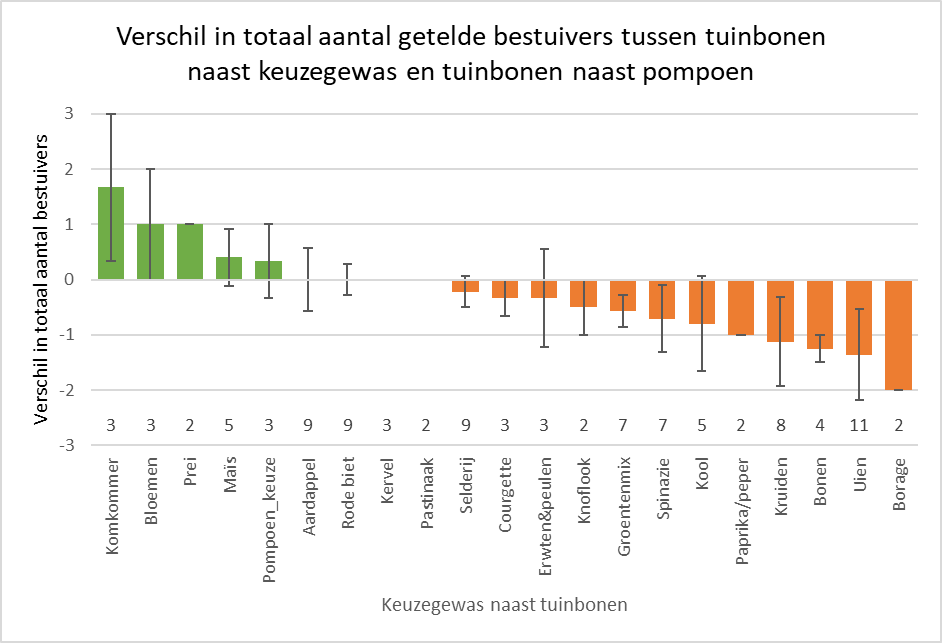
The statistical tests revealed no proven differences between broad beans next to the different choice crops and next to pumpkin. However, onions were very close to the limit we use for this purpose. This could be an indication that broad beans next to onions are less frequently visited by pollinators. So although we cannot draw this conclusion with certainty this year, onions are an interesting choice crop to keep an eye on when it comes to pollinators.
A wet year
Due to a lot of rain this year, conditions were not always best for counting pollinators. Indeed, pollinating insects like to fly when it is sunny, dry and not too cold. During the flowering of broad beans, it was mostly cloudy, rainy and cold. This unfortunately prevented a group of enthusiastic participants from counting pollinators. With another year of data (and hopefully some nicer weather), it will probably be possible to draw better conclusions about the effects of different choice crops on pollinators.
Aphids
To assess how much the broad beans suffered from aphids, we used a score from 0 to 5. Where 0 means ‘no aphids’ and score 5 means more than half of the plant was covered with aphids. For each garden, we compared whether the score for broad beans next to the choice crop was higher or lower than the score for broad beans next to pumpkin. So in this case, higher scores are worse as they indicate more aphids. The choice crops next to broad beans had more aphids are shown in orange in the graph below. In green, you can see the choice crops next to which broad beans suffered less from aphids on average. You can see, for example, that broad beans next to lettuce had fewer aphids than next to pumpkin, but broad beans next to potato had more aphids than next to pumpkin.
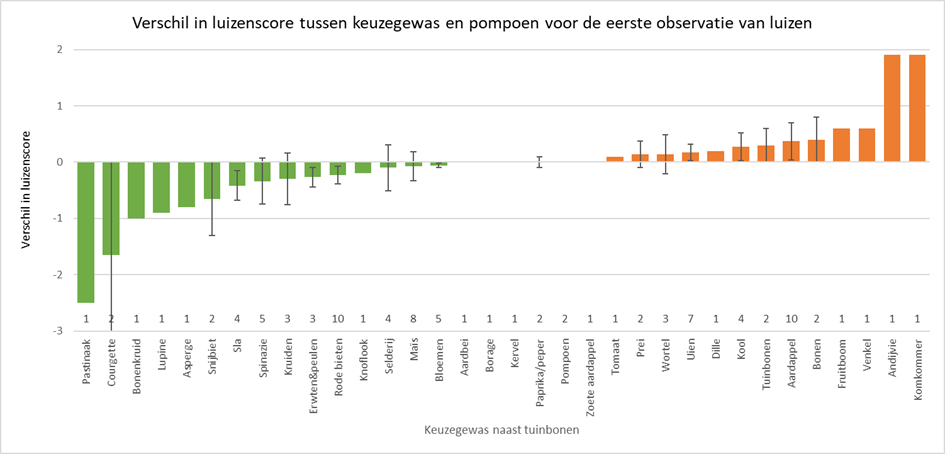
Small differences
The differences in louse scores were small in many cases, especially for crops tested by multiple participants. The statistical test, therefore, indicated that the differences seen may only be coincidental.
This does not mean that it doesn't matter to aphids which crop you put next to broad beans. As with pollinators, it is quite possible that we can see differences if we repeat the experiment for another year (or even more often). In that case, the choice crops have been tested more often. Furthermore, some participants measured aphid infestation again at harvest, but this group was also too small this year to draw any conclusions. With this, if we have more years of data, we can also look at the effect of different choice crops on aphid decline between flowering and harvest.
Natural enemies of aphids
With the arrival of aphids, natural enemies also come to the broad beans. Besides the aphid counts, you also looked at the number of natural enemies of aphids on broad beans. Again, for each choice crop, we calculated the difference between the total number of natural enemies next to the choice crop and next to pumpkin. In green the broad beans next to choice crops where more natural enemies were counted than next to pumpkin, in orange the crops where fewer natural enemies were counted than next to pumpkin.
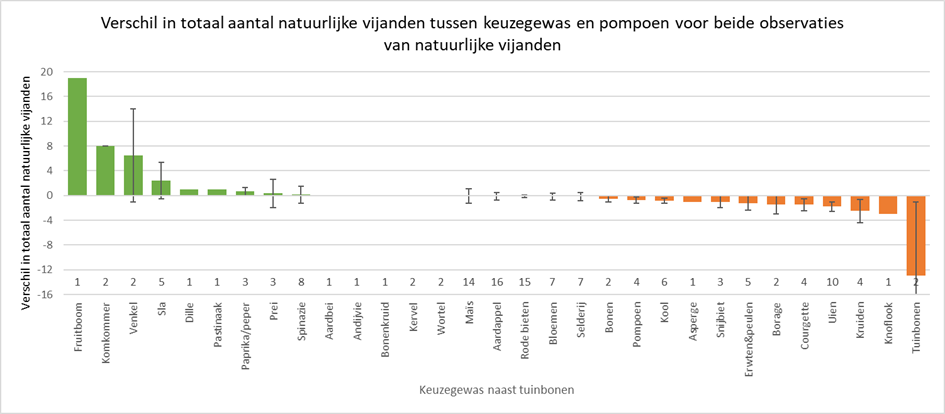
As for pollinators, no proven (significant) differences emerge in the statistical tests between broad beans next to pumpkin and next to the different choice crops. This is true both if we look at only the first count, only the second count or both counts together. However, if we look at both counts together then lettuce comes close to the limit we use for this. Based on these (not significant) results, we cannot yet say with certainty that lettuce is a good choice crop in view of natural control agents, but it is an interesting crop to keep an eye on next year.
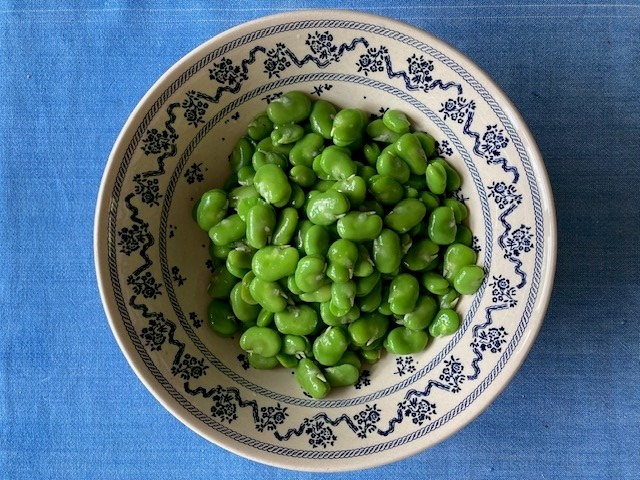
Picture by participant Lisa (2024).
Join another season of the experiment!
To draw better conclusions, it is important to repeat this experiment next year. Will we still see the same crops having a positive or negative effect? Would you like to participate in the experiment? Registration for the 2026 season will open in early 2026. Keep an eye on the website for more information!
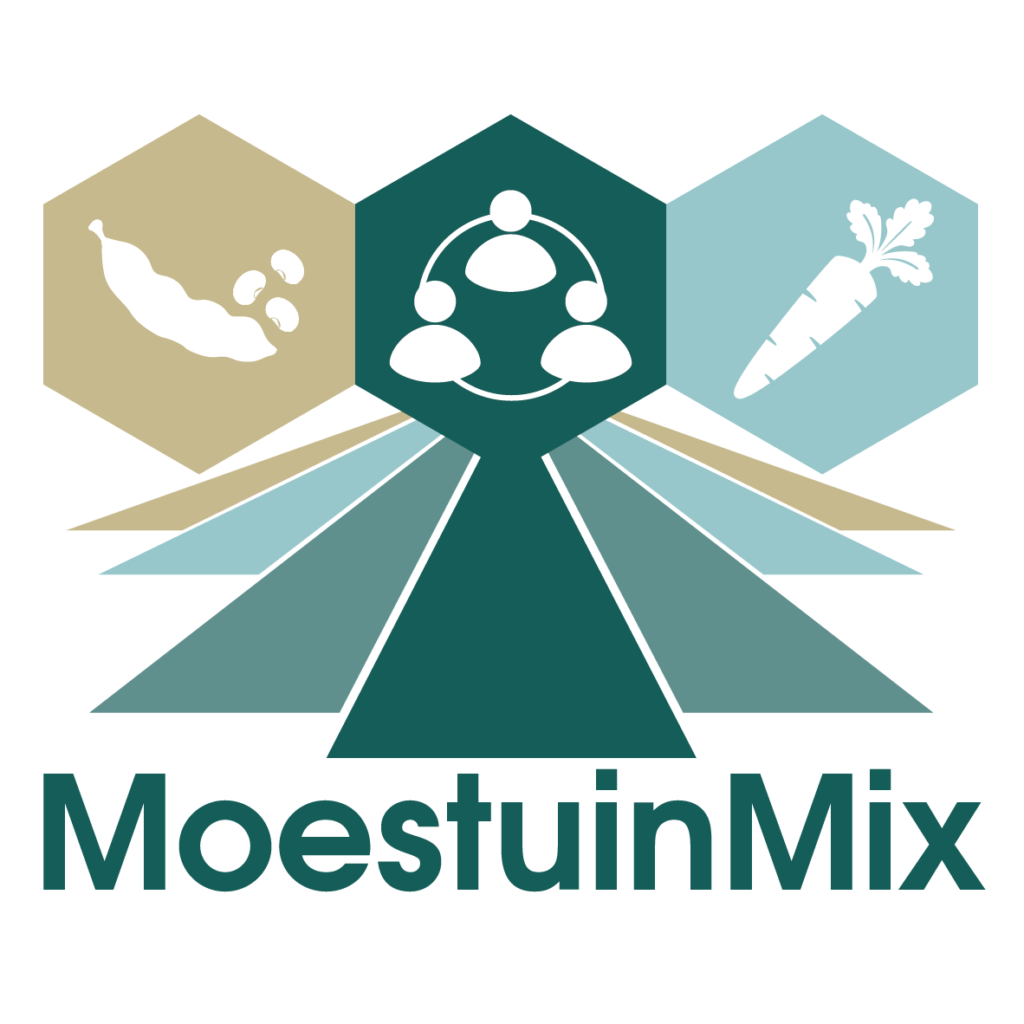
MoestuinMix is a citizen science project in which non professional vegetable growers and gardeners experiment with different crop combinations.
In collaboration with

More information
Would you like to know more or do you have questions? Please contact us via moestuinmix@wur.nl.
For news and updates, follow CropMix on LinkedIn
Frequently asked questions
I participated in 2024 or 2025. Can I join again?
Certainly! We will repeat the experiment in 2026. Everyone can participate, including people who did not participate in 2024 or 2025. Registration will open in the beginning of 2026.
Broad bean and pumpkin are not together in the garden for most of the season. Why did you choose this combination?
- Broad beans are an early crop and much of the season the broad bean is alone in the garden. If we adjust the sowing density and make room to sow pumpkin later on, each broad bean plant will get more light. The broad bean has less competition from its peers. For the pumpkin, on the other hand, it is planted or sown late and takes up very little space in the beginning. Once the broad beans are harvested, the pumpkin can take up space from the broad beans. In science, we call this 'temporal niche differentiation' and this seems to have the greatest advantage in areas with temperate climates.
- Broad beans are so-called nitrogen fixers, due to their cooperation with soil bacteria. These bacteria supply nitrogen to the broad bean in exchange for sugars from the broad bean. When the broad bean dies, the plants and root remnants of the bacteria remain, passing on the captured nitrogen to the next crop, in this case pumpkin. Broad beans also stimulate beneficial soil bacteria from which the pumpkin can in turn benefit.
- Pumpkin and broad beans are both interesting for pollinating insects. By growing them together, pollinators can use the same place over a longer period of time this saves them searching time.
- Pumpkin and broad bean can both suffer from aphids. In healthy ecosystems, the aphids will also attract natural enemies. When the pumpkin is planted, there is already an army of natural pest controllers ready to protect the pumpkin as well.
These are all advantages that may occur. If they do occur is the question that we are trying to answer with your help.
Who is behind MoestuinMix?
Researchers from Wageningen University & Research coordinate CropMix, a five-year research programme, and the experiments in MoestuinMix. Here, we work together with AVVN samen natuurlijk tuinieren.
Why do you ask the help of vegetable gardeners?
A vegetable or kitchen garden is pre-eminently a place where crop diversity is high, but there are also big differences between gardens. For instance, in soil type, type of environment and which crops are grown. This provides interesting data.
Moreover, vegetable gardeners often have a lot of valuable knowledge about combining crops. We like to retrieve that knowledge to see what insights could be useful for arable farmers.
What is the goal of the experiment?
Our aim is to learn more about crop diversity and how it works in practice in a vegetable garden or in a field. We are specifically looking for crop combinations that promote cultivation and the processes that ensure this. This knowledge could be important for farmers who want to work with crop diversity in their fields.
What is the role of AVVN?
AVVN samen natuurlijk tuinieren is a partner in the CropMix consortium. We work together in building the MoestuinMix experiments, aimed at people with a kitchen garden.
Is you question not answered above? You can send us an email at moestuinmix@wur.nl.
MoestuinMix is a collaboration between CropMix and AVVN samen natuurlijk tuinieren.
